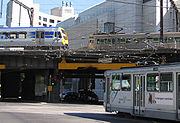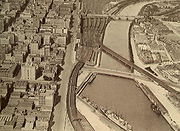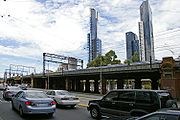
Flinders Street Viaduct
Encyclopedia

Melbourne
Melbourne is the capital and most populous city in the state of Victoria, and the second most populous city in Australia. The Melbourne City Centre is the hub of the greater metropolitan area and the Census statistical division—of which "Melbourne" is the common name. As of June 2009, the greater...
, Australia
Australia
Australia , officially the Commonwealth of Australia, is a country in the Southern Hemisphere comprising the mainland of the Australian continent, the island of Tasmania, and numerous smaller islands in the Indian and Pacific Oceans. It is the world's sixth-largest country by total area...
. Made up of six tracks of varying ages, it links Flinders Street Station
Flinders Street Station
Flinders Street Station is the central railway station of the suburban railway network of Melbourne, Victoria, Australia. It is on the corner of Flinders and Swanston Streets next to the Yarra River in the heart of the city, stretching from Swanston Street to Queen Street and covering two city...
to Southern Cross Station
Southern Cross Station
Southern Cross is a major railway station and transport hub in Melbourne Docklands, Victoria, Australia. It is located on Spencer Street between Collins and La Trobe Streets at the western edge of the central business district...
and forms the main link between the eastern and western parts of the Victorian rail network
Rail transport in Victoria
Rail transport in Victoria, Australia, is provided by a number of railway operators who operate over the government-owned railway lines. Victorian lines use broad gauge, with the exception of a number of standard gauge freight and interstate lines, a few experimental narrow gauge lines, and...
.
The viaduct takes a twisted path, passing behind the former Victorian Railways
Victorian Railways
The Victorian Railways operated railways in the Australian state of Victoria from 1859 to 1983. The first railways in Victoria were private companies, but when these companies failed or defaulted, the Victorian Railways was established to take over their operations...
headquarters at 67 Spencer Street
67 Spencer Street
67 Spencer Street is the former head offices of the Victorian Railways, located on Spencer Street, Melbourne, Australia. Today it is used as a hotel and apartments...
, taking a sharp 90 degree turn east from Spencer Street, swinging southward around the back of the former Fish Market (now Northbank Place and Rebecca Walk) beside Batman Park
Batman Park
Batman Park is an urban park, located on the northern bank of the Yarra River in central Melbourne, Victoria, Australia.Batman Park is a small open grassed space with paths and planted Eucalyptus trees bordered by Spencer Street at the west, Flinders Street Viaduct at the north and King Street to...
, then north-east to avoid the swinging basin on the Yarra River
Yarra River
The Yarra River, originally Birrarung, is a river in east-central Victoria, Australia. The lower stretches of the river is where the city of Melbourne was established in 1835 and today Greater Melbourne dominates and influences the landscape of its lower reaches...
, then crossing over the Banana Alley Vaults
Banana Alley, Melbourne
The Banana Alley Vaults are near the Flinders Street Station in Melbourne, Australia and extend onto the North Bank of the Yarra River.Built in 1891-92, whey were originally known as the Viaduct Buildings, and were built in conjunction with the tracks of the Flinders Street Viaduct that run overhead...
before entering Flinders Street.
Background

Port Melbourne railway line, Melbourne
The Port Melbourne railway line is a former suburban railway in Melbourne, Australia. The line was the first significant railway in Australia and was opened by the Melbourne and Hobson's Bay Railway Company to carry passengers arriving in Victoria at Station Pier, and to alleviate the high cost of...
. Railways continued to be built from Flinders Street, and the adjacent Princes Bridge station
Princes Bridge railway station, Melbourne
Princes Bridge was a Melbourne railway station built in 1859 and was the terminus for all Epping line and Hurstbridge line trains. The station was named after the adjacent Princes Bridge, which crosses the Yarra River. Originally Princes Bridge station was isolated from Flinders Street Station,...
. At the same time, a number of country railways had been built to the west of Melbourne, and used Spencer Street station (now Southern Cross) as the terminus.
Many residents saw the Spencer Street terminal as undesirable and inconvenient, as it was at the edge of the then city, and as early as 1861 a deputation of residents called on the Railway Commissioner to improve matters. It was not until 1879 that the Melbourne Railway Station Junctions Act was passed, which authorised a ground level connection. Three quarters of a mile long, it was classified as a tramway and had limits on the operational speeds, noise and motive power used. In addition, it could only be used at night, and had a level crossing
Level crossing
A level crossing occurs where a railway line is intersected by a road or path onone level, without recourse to a bridge or tunnel. It is a type of at-grade intersection. The term also applies when a light rail line with separate right-of-way or reserved track crosses a road in the same fashion...
with Queensbridge Street.
History



Double track
A double track railway usually involves running one track in each direction, compared to a single track railway where trains in both directions share the same track.- Overview :...
opened for goods traffic the next month, but teething problems limited the viaduct to a single line
Single track (rail)
A single track railway is where trains in both directions share the same track. Single track is normally used on lesser used rail lines, often branch lines, where the traffic density is not high enough to justify the cost of building double tracks....
during February 1892. The viaduct was designed and its construction and duplication supervised by Frederick Esling
Frederick Esling
Frederick Karl Esling was an Australian railway engineer and chess master.-Railway career:...
who also was author of a technical paper which identified a puzzling problem related to the horizontal forces on the viaduct due to braking, in combination with side forces from wind-pressure.
The ground level tramway was cut back, but part was retained as a siding to serve the Melbourne Fish Market on Flinders Street, and was not lifted until 1929.
From December 1894 suburban traffic on the Williamstown and Essendon line began to use the viaduct, after the construction of additional platforms at Spencer Street Station
Southern Cross Station
Southern Cross is a major railway station and transport hub in Melbourne Docklands, Victoria, Australia. It is located on Spencer Street between Collins and La Trobe Streets at the western edge of the central business district...
. To provide for the growing amount of traffic, the viaduct was duplicated in 1915 to provide four tracks in total, with a new bridge being built to one side. The old bridge was then closed and strengthened, being reopened in 1917.
This remained until the 1970s, when in conjunction with the City Loop project, the existing viaduct tracks were made part of four independent loops around the Melbourne CBD. An additional bridge was built alongside, 722 metres long with precast concrete
Precast concrete
By producing precast concrete in a controlled environment , the precast concrete is afforded the opportunity to properly cure and be closely monitored by plant employees. Utilizing a Precast Concrete system offers many potential advantages over site casting of concrete...
box girder
Box girder
A box or tubular girder is a girder that forms an enclosed tube with multiple walls, rather than an or H-beam. Originally constructed of riveted wrought iron, they are now found in rolled or welded steel, aluminium extrusions or pre-stressed concrete....
s, each girder carrying a single rail track, with each span 30 to 35 metres long, the new bridge taking a straighter path because the turning basin had been filled in. Work begun in December 1975, with the new bridge opened in December 1978. Work then begun on rehabilitating and upgrading the existing bridge, with two tracks being taken out of use at a time. The new bridge was signalled for a trains travelling in a single direction on each line, but the four tracks on the older viaduct were resignalled for bidirectional use, as the operation of the City Loop would be reversed between morning and after peaks.
The land under the Viaduct has been used for various uses: when the King Street Bridge
King Street Bridge (Melbourne)
The King Street Bridge takes King Street over the Yarra River in Melbourne, Victoria, Australia. The bridge continues south as an elevated viaduct, with the Crown Casino and Entertainment Complex built around it in later years.-History:...
was built in 1958 the land was turned over to the City of Melbourne
City of Melbourne
The City of Melbourne is a Local Government Area in Victoria, Australia, located in the central city area of Melbourne. The city has an area of 36 square kilometres and has an estimated population of 93,105 people. The city's motto is "Vires acquirit eundo" which means "She gathers strength as she...
, who used it as a car impound yard
Tow truck
A tow truck is a vehicle used to transport motor vehicles to another location , or to recover vehicles which are no longer on a drivable surface.Towing services are generally provided by an emergency road service operator...
for parking offences. This was repealed in 2003 when the Flinders Street overpass of King Street was demolished. The original viaduct was re-decked in 2000, from near Spencer Street through to near Market Street.
In 1997 the Northbank area was redeveloped, with the turning basin expanded and the newer viaduct bathed in blue light by night, in an artwork titled 'Blue Line' by Peter McNeill Stitt that includes 1.4 kilometres of neon tubing. The Melbourne Aquarium
Melbourne Aquarium
Melbourne Aquarium is a Southern Ocean and Antarctic aquarium in central Melbourne, Australia. It is located on the banks of the Yarra River beside and under the Flinders Street Viaduct and the King Street Bridge.-History:...
was built under and around the newest viaduct between February 1998 and December 1999, and is being expanded under the four track viaduct towards Flinders Street. Construction of apartment buildings on the former fish market site commenced in 2007, and resulted in the railway signal
Railway signal
A signal is a mechanical or electrical device erected beside a railway line to pass information relating to the state of the line ahead to train/engine drivers. The driver interprets the signal's indication and acts accordingly...
s needing to be altered, due to the altered sight lines for trains coming around the curve.
As part of the Northbank Place development in 2010, three 11-storey mixed use towers were built on the former Fish Market site, and the area under the viaduct bordering Batman Park
Batman Park
Batman Park is an urban park, located on the northern bank of the Yarra River in central Melbourne, Victoria, Australia.Batman Park is a small open grassed space with paths and planted Eucalyptus trees bordered by Spencer Street at the west, Flinders Street Viaduct at the north and King Street to...
was converted into commercial space named "Rebecca Walk" in reference to the Schooner Rebecca
Schooner Rebecca
The 30-ton sloop Rebecca was launched in 1834, built by Captain George Plummer at his boatyard on the banks of the Tamar River at Rosevears, Van Diemen's Land ....
.

